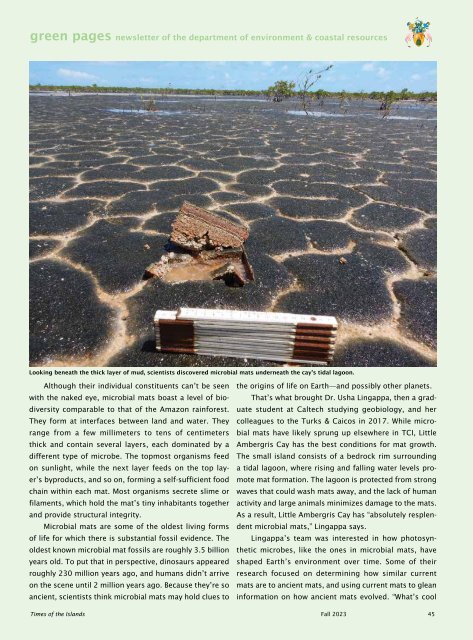Times of the Islands Fall 2023
Presents the "soul of the Turks & Caicos Islands" with in-depth features about local people, culture, history, environment, real estate, businesses, resorts, restaurants and activities.
Presents the "soul of the Turks & Caicos Islands" with in-depth features about local people, culture, history, environment, real estate, businesses, resorts, restaurants and activities.
Create successful ePaper yourself
Turn your PDF publications into a flip-book with our unique Google optimized e-Paper software.
green pages newsletter <strong>of</strong> <strong>the</strong> department <strong>of</strong> environment & coastal resources<br />
Looking beneath <strong>the</strong> thick layer <strong>of</strong> mud, scientists discovered microbial mats underneath <strong>the</strong> cay’s tidal lagoon.<br />
Although <strong>the</strong>ir individual constituents can’t be seen<br />
with <strong>the</strong> naked eye, microbial mats boast a level <strong>of</strong> biodiversity<br />
comparable to that <strong>of</strong> <strong>the</strong> Amazon rainforest.<br />
They form at interfaces between land and water. They<br />
range from a few millimeters to tens <strong>of</strong> centimeters<br />
thick and contain several layers, each dominated by a<br />
different type <strong>of</strong> microbe. The topmost organisms feed<br />
on sunlight, while <strong>the</strong> next layer feeds on <strong>the</strong> top layer’s<br />
byproducts, and so on, forming a self-sufficient food<br />
chain within each mat. Most organisms secrete slime or<br />
filaments, which hold <strong>the</strong> mat’s tiny inhabitants toge<strong>the</strong>r<br />
and provide structural integrity.<br />
Microbial mats are some <strong>of</strong> <strong>the</strong> oldest living forms<br />
<strong>of</strong> life for which <strong>the</strong>re is substantial fossil evidence. The<br />
oldest known microbial mat fossils are roughly 3.5 billion<br />
years old. To put that in perspective, dinosaurs appeared<br />
roughly 230 million years ago, and humans didn’t arrive<br />
on <strong>the</strong> scene until 2 million years ago. Because <strong>the</strong>y’re so<br />
ancient, scientists think microbial mats may hold clues to<br />
<strong>the</strong> origins <strong>of</strong> life on Earth—and possibly o<strong>the</strong>r planets.<br />
That’s what brought Dr. Usha Lingappa, <strong>the</strong>n a graduate<br />
student at Caltech studying geobiology, and her<br />
colleagues to <strong>the</strong> Turks & Caicos in 2017. While microbial<br />
mats have likely sprung up elsewhere in TCI, Little<br />
Ambergris Cay has <strong>the</strong> best conditions for mat growth.<br />
The small island consists <strong>of</strong> a bedrock rim surrounding<br />
a tidal lagoon, where rising and falling water levels promote<br />
mat formation. The lagoon is protected from strong<br />
waves that could wash mats away, and <strong>the</strong> lack <strong>of</strong> human<br />
activity and large animals minimizes damage to <strong>the</strong> mats.<br />
As a result, Little Ambergris Cay has “absolutely resplendent<br />
microbial mats,” Lingappa says.<br />
Lingappa’s team was interested in how photosyn<strong>the</strong>tic<br />
microbes, like <strong>the</strong> ones in microbial mats, have<br />
shaped Earth’s environment over time. Some <strong>of</strong> <strong>the</strong>ir<br />
research focused on determining how similar current<br />
mats are to ancient mats, and using current mats to glean<br />
information on how ancient mats evolved. “What’s cool<br />
<strong>Times</strong> <strong>of</strong> <strong>the</strong> <strong>Islands</strong> <strong>Fall</strong> <strong>2023</strong> 45
















